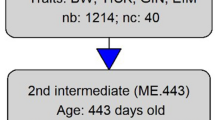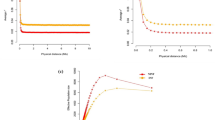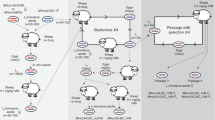Abstract
The differences in host response among strains of rats to intestinal nematode parasite Trichinella spiralis infection could provide a powerful benefit for further elucidation of molecular interactions between the host and the parasite. Using several strains of rats, we previously observed that DA strain is a strong responder and F344 strain is a weak responder with respect to expulsion of the adult worm. To identify the host resistance loci, quantitative trait loci (QTLs) analysis in F2 population from crosses between DA and F344 strains was performed. One significant QTL (designated as Tspe) was mapped to the middle region of chromosome 9. In addition, the effect of DA allele at Tspe locus could act recessively and lead to the rejection of more adult worms from the gut. The results from the present study provide more insights on host–parasite interactions, which may be useful in facilitating the development of novel approaches for treatment and control of intestinal parasites in human and domestic livestock.



Similar content being viewed by others
References
Behnke JM, Iraqi FA, Menge DM, Baker RL, Gibson JP, Wakelin D (2003) Chasing the genes that control resistance to gastrointestinal nematodes. J Helminthol 77:99–109
Bell RG (1992) Variation in responsiveness to Trichinella spiralis infection in inbred rat strains. Parasitology 105:125–130
Bell RG (1998) The generation and expression of immunity to Trichinella spiralis in laboratory rodents. Adv Parasitol 41:149–217
Bell RG, Adams LS, Ogden RW (1984) A single gene determines rapid expulsion of Trichinella spiralis in mice. Infect Immun 45:273–275
Casanova JL, Schurr E, Abel L, Skamene E (2002) Forward genetics of infectious diseases: immunological impact. Trends Immunol 23:469–472
Churchill GA, Doerge RW (1994) Empirical threshold values for quantitative trait mapping. Genetics 138:963–971
Darvasi A, Soller M (1992) Selective genotyping for determination of linkage between a molecular marker and a quantitative trait locus. Theor Appl Genet 85:353–359
Dehlawi MS, Goyal PK (2003) Resposes of inbred mouse strains to infection with intestinal nematodes. J Helminthol 77:119–124
Dietrich WF (2001) Using mouse genetics to understand infectious disease pathogenesis. Genome Res 11:325–331
Else KJ, Finkelman FD (1998) Intestinal nematode parasites, cytokines and effector mechanisms. Int J Parasitol 28:1145–1158
Grencis RK (2001) Cytokine regulation of resistance and susceptibility to intestinal nematode infection—from host to parasite. Vet Parasitol 100:45–50
Helmby H, Grencis RK (2002) IL-18 regulates intestinal mastocytosis and Th2 cytokine production independently of IFN-γ during Trichinella spiralis infection. J Immunol 169:2553–2560
Hutloff A, Dittrich AM, Beier KC, Eljaschewitsch B, Kraft R, Anagnostopoulos I, Kroczek RA (1999) ICOS is an inducible T-cell co-stimulator structurally and functionally related to CD28. Nature 397:263–266
Iraqi F, Calpcott SJ, Kumari P, Haley CS, Kemp SJ, Teale AJ (2000) Fine mapping of trypanosomiasis resistance loci in murine advanced intercross lines. Mamm Genome 11:645–648
Iraqi FA, Behnke JM, Menge DM, Lowe A, Teale AJ, Gibson JP, Wakelin D (2003) Chromosomal regions controlling resistance to gastro-intestinal nematode infections in mice. Mamm Genome 14:184–191
Kapel CMO (2005) Changes in the EU legislation on Trichinella inspection —new challenges in the epidemiology. Vet Parasitol 132:189–194
Lander ES, Botstein D (1989) Mapping mendelian factors underlying quantitative traits using RFLP linkage maps. Genetics 121:185–199
Manly KF, Cudmore RH Jr, Meer JM (2001) Map Manager QTX, cross-platform software for genetic mapping. Mamm Genome 12:930–932
Menge DM, Behnke JM, Lowe A, Gibson JP, Iraqi FA, Baker RL, Wakelin D (2003) Mapping of chromosomal regions influencing immunological responses to gastrointestinal nematode infections in mice. Parasite Immunol 25:341–349
Min-Oo G, Fortin A, Tam MF, Nantel A, Stevenson MM, Gros P (2003) Pyruvate kinase deficiency in mice protects against malaria. Nat Genet 35:357–362
Murrell KD, Pozio E (2000) Trichinellosis: the zoonosis that won’t go quietly. Int J Parasitol 30:1339–1349
Ohno T, Ishih A, Tanaka S, Nishimura M, Terada M (2002) Chromosomal mapping of host susceptibility loci to Angiostrongylus costaricensis nematode infection in mice. Immunogenetics 53:925–929
Pozio E, Marucci G (2003) Trichinella-infected pork products: a dangerous gift. Trends Parasitol 19:338
Shahinian PH, Bothwell ALM, Mueller-Hill B, Baltimore D (1993) Differential T cell costimulatory requirements in CD28-deficient mice. Science 261:609–612
Urban JF Jr, Schopf L, Morris SC, Orekhova T, Madden KB, Betts CJ, Gamble HR, Byrd C, Donaldson D, Else K, Finkelman FD (2000) Stat6 signaling promotes protective immunity against Trichinella spiralis through a mast cell- and T cell-dependent mechanism. J Immunol 164:2046–2052
Villegas EN, Lieberman LA, Mason N, Blass SL, Zediak VP, Peach R, Horan T, Yoshinaga S, Hunter CA (2002) A role for inducible costimulator protein in the CD28-independent mechanism of resistance to Toxoplasma gondii. J Immunol 169:937–943
Wakelin D, Goyal PK (1996) Trichinella isolates: parasite variability and host responses. Int J Parasitol 26:471–481
Wassom DL, Wakelin D, Brooks BO, Krco CJ, David CS (1983) Trichinella spiralis: role of non-H-2 genes in resistance to primary infection in mice. Exp Parasitol 55:153–158
Watanabe N, Bruschi F, Korenaga M (2005) IgE: a question of protective immunity in Trichinella spiralis infection. Trends Parasitol 21:175–178
Author information
Authors and Affiliations
Corresponding author
Rights and permissions
About this article
Cite this article
Suzuki, T., Ishih, A., Kino, H. et al. Chromosomal mapping of host resistance loci to Trichinella spiralis nematode infection in rats. Immunogenetics 58, 26–30 (2006). https://doi.org/10.1007/s00251-005-0079-9
Received:
Accepted:
Published:
Issue Date:
DOI: https://doi.org/10.1007/s00251-005-0079-9




